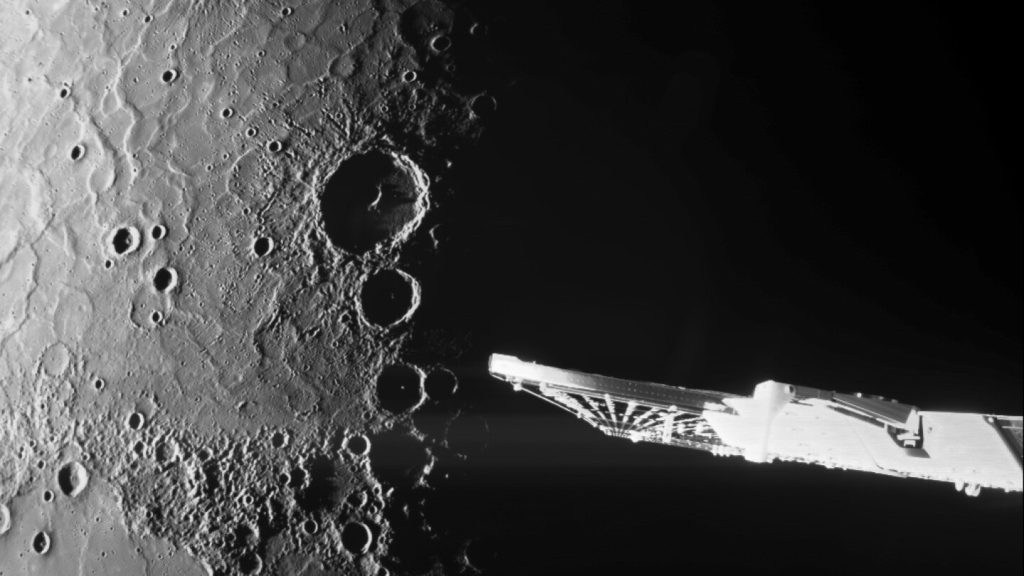Paragraph 1: A Historic Encounter with Mercury’s North Pole
The BepiColombo spacecraft, a joint European-Japanese mission, has provided humanity with an unprecedented glimpse into the enigmatic north pole of Mercury. Executing its sixth and final flyby of the planet, the spacecraft swooped down to a mere 183 miles (295 kilometers) above Mercury’s night side before soaring directly over the north pole. This maneuver allowed the onboard cameras to capture stunning high-resolution images of the permanently shadowed craters that dot this region, unveiling details never before seen. This close encounter marks a pivotal moment in planetary exploration, offering crucial data to unravel the mysteries of our solar system’s smallest and innermost planet.
Paragraph 2: Unveiling Mercury’s Diverse Terrain
Beyond the north pole, BepiColombo’s cameras also surveyed a wider swathe of Mercury’s surface, capturing breathtaking images of diverse geological features. The spacecraft’s instruments documented vast volcanic plains, evidence of the planet’s dynamic past. It also imaged Mercury’s largest impact crater, a colossal scar spanning more than 930 miles (1,500 kilometers), a testament to the violent bombardment the planet has endured over billions of years. These images provide valuable insights into the geological evolution of Mercury and the processes that have shaped its surface.
Paragraph 3: The Significance of BepiColombo’s Mission
This sixth flyby represents a crucial milestone for the BepiColombo mission. It marks the culmination of a series of intricate gravitational assists, using the gravity of Earth, Venus, and Mercury itself to fine-tune the spacecraft’s trajectory. These flybys have gradually slowed BepiColombo down, preparing it for the ultimate goal: entering into orbit around Mercury in late 2025. Once in orbit, the spacecraft, comprised of two separate orbiters—one European and one Japanese—will commence a comprehensive study of Mercury’s composition, magnetic field, and interaction with the solar wind.
Paragraph 4: The Scientific Objectives of BepiColombo
BepiColombo’s mission aims to address fundamental questions about Mercury’s formation, evolution, and its unique characteristics. Scientists hope to gain a deeper understanding of the planet’s unusually large iron core, its weak magnetic field, the presence of water ice in permanently shadowed craters, and the surprising abundance of volatile elements. By meticulously mapping Mercury’s surface and analyzing its composition, the mission seeks to shed light on the processes that have shaped this intriguing planet and its place within the solar system. The data collected will contribute significantly to our understanding of planetary formation and evolution more broadly.
Paragraph 5: A Tribute to Giuseppe Colombo
The BepiColombo mission carries the name of Giuseppe (Bepi) Colombo, a renowned Italian mathematician and scientist. Colombo’s groundbreaking work in celestial mechanics significantly contributed to the success of NASA’s Mariner 10 mission, the first spacecraft to visit Mercury in the 1970s. His calculations revealed that a spacecraft could use Venus’s gravity to slingshot itself towards Mercury, allowing for multiple flybys with minimal fuel expenditure. This technique, now a cornerstone of interplanetary travel, revolutionized our ability to explore the inner solar system. BepiColombo’s namesake pays homage to Colombo’s pioneering contributions to space exploration.
Paragraph 6: The Future of Mercury Exploration
The data gathered during BepiColombo’s flybys and subsequent orbital phase will provide scientists with a treasure trove of information about Mercury. This mission represents a significant leap forward in our understanding of this enigmatic planet. The high-resolution images, detailed compositional analyses, and measurements of Mercury’s magnetic field will pave the way for future exploration. The insights gained from BepiColombo will inform the development of future missions and potentially even robotic landers, allowing us to delve even deeper into the secrets of Mercury and further our understanding of the diverse worlds that populate our solar system.

